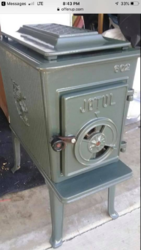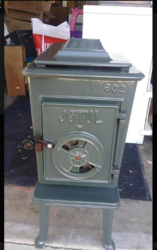I just went and picked up a Jotul 602 this past Sunday. I have looked at them from time to time and this one popped up and I could not pass up the deal. Drove about 5 hours total to pick it up. It looks like it may have only had a fire or two in it. Hardly used.
I got it for an upstairs room and hallway area with low ceilings (7').
Can't wait to get it hooked up and try it out. Hole is already in the wall for the stove pipe and goes into the existing chimney. Just need to figure out what I want to do for the pipe and hearth pad.
Pics are from the sellers add. I have yet to get it out of the back of the car...
I got it for an upstairs room and hallway area with low ceilings (7').
Can't wait to get it hooked up and try it out. Hole is already in the wall for the stove pipe and goes into the existing chimney. Just need to figure out what I want to do for the pipe and hearth pad.
Pics are from the sellers add. I have yet to get it out of the back of the car...



